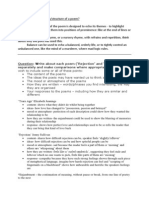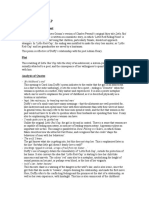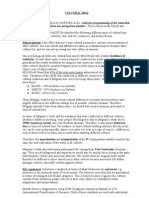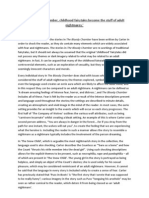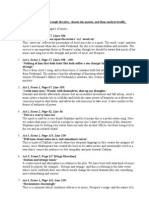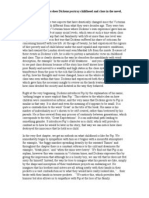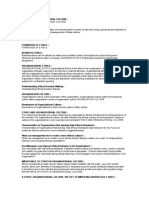The Macabre' GCSE Pre-1914 Poetry Coursework
The Macabre' GCSE Pre-1914 Poetry Coursework
Uploaded by
Miss_M90Copyright:
Available Formats
The Macabre' GCSE Pre-1914 Poetry Coursework
The Macabre' GCSE Pre-1914 Poetry Coursework
Uploaded by
Miss_M90Original Title
Copyright
Available Formats
Share this document
Did you find this document useful?
Is this content inappropriate?
Copyright:
Available Formats
The Macabre' GCSE Pre-1914 Poetry Coursework
The Macabre' GCSE Pre-1914 Poetry Coursework
Uploaded by
Miss_M90Copyright:
Available Formats
The Macabre GCSE Pre- 1914 Poetry Coursework
How and in what ways have the poets in this anthology conveyed the macabre? The macabre is a fictional text that captures the mystery of the supernatural, horror, sinister and apprehension that ultimately conveys fear. The Raven, La Belle Dame Sans Merci, Tiger, The Listeners, Flannan Isle and Kraken are the poems I will be looking at. They all contain the macabre in some form, and I can identify how they are conveyed by looking at the themes. The themes I have decided to observe are the sinister characteristics, disguise, and the supernatural. A sinister atmosphere is created in two of the poems through various ways; The Raven uses particular dark vocabulary for example, dreary and silence- the repetition of darkness and the personification of dying ember wrought its ghost, results in cold creepy images. The dying gives us images of death including ghosts, which almost represents shadows lurking. This may tell us that the narrator feels haunted. Ghosts are a common feature for sinister elements and are part of the supernatural; they are stereotyped as evil and frightening creatures who try to kill or haunt living people. This idea of this specific supernatural aspect is used in the The Listeners where phantoms (similar to ghosts) are stated in the poem. Mare uses words that create dark scenes such as dark turf and uses sensory images, those that appeal to our senses. Fell echoing through the shadowiness is a quote in the poem that describes what we could hear. There is also the mention of shadows again, which adds to the sinister mood and the way it relates to ghosts. The way Poe has set out the structure of The Raven, including repetitions for example, rapping, rapping at my chamber door gives a sense of sinister rhythm and apprehension. The fact that it begins with Once upon a immediately makes us think of fairy tales. This provides the sinister element that all fairy tales seem to have in some way. Usually there would be a happy ending therefore we assume there will be one, but this does not take place, therefore it is ironic. Mare sets the scene by using clich words such as moonlight and dark hooves which are regularly seen in scary movies and stories. When we read in the poem that the traveller knocks on the door and later there are phantoms, suggests another usual clich- a haunted house. Here, we have images of people being murdered, screams of terror echoing through the air, and blood being splattered on walls. When someone enters a haunted house, we normally think that he or she wont come out alive. Clichs are something that many people in the world know about or are familiar with; therefore, poets using this technique help readers enhance their imagination as it is familiar to them and describes a situation without having to use so many words. One of the main features that are treated as a sinister factor in The Raven is the raven itself. The raven is symbolically known as a bird of ill omen, therefore it is not really considered as the one of the luckiest creature to see. This idea of using the bird as a symbolic means is again used in Flannan Isle.
English Coursework
Although it does not say that there are ravens, but the description given illustrates a similar image, the black feathers, the word queer describes that these three black birds are rather odd and strange, which is one of the comparables described for the raven as well because of the way it acts. Most of all, a raven is a distinct bird that is known for how unusually large it is, and the fact that in Flannan Isle it says, Too big by far, in my belief illustrates another similarity to the raven. Perched, and sat, and nothing more. is the last line, in verse seven suggests this particular bird has some sort of purpose. It is strange that he is not flapping its wings or moving at all, as it says not a feather he fluttered. The way the raven simply stares at the narrator with its fiery eyes with such a stern decorum meaning strict behaviour-the way it holds itself as still as a statue is somewhat abnormal, and not what you would expect how a normal bird to behave. There is also the idea that the raven maybe from hell because the narrator says, Tell me what thy lordly name is on the Nights Plutonian shore! The word plutonian is the characteristic of Pluto, who is considered as the god of the underworld in Roman mythology, and therefore it is thought that the raven maybe a creature from the land of the dead. The fact that a particular question is repeated gives a sense of uneasiness, urgency, and alarm because it makes the reader think again of the question in more depth. This technique is used in The listeners- Is there anybody there? and La Belle O what can ail thee, knight-at-arms!. The bust of Pallas is something of wisdom. Pallas was a god of wisdom, sometimes known as Pallas Athene, and so by placing the raven above the bust of Pallas, Poe creates a situation in which wisdom has been placed under the raven, and sort of brings up an old clich where there is the battle of good and evil. In this case, good is being taken over evil. The repetition of Nevermore by the raven is atypical and peculiar, this also relates to the supernatural. Why use a bird- a raven at that, to be a messenger and one that does not talk but a single word- Nevermore is a mystery, it is supernatural because it is clear that this black bird is no ordinary one. Colour image is portrayed, for example, on the cushions velvet violet linings using the technique of alliteration to give effect and adds to the rhythm. The fact that Poe used this particular word to describe the colour gives it a certain depth. Poe could have said purple, but instead he wrote violet, which is a deep, dark purple, which in turn gives a sense of murkiness to it which purple would not have been able to express. In the first stanza of La Belle Dame Sans Merci, a lifeless feeling is slowly being described, images of gloominess and unhappiness instantly starts to arise due to the cold words being used, for example Alone and palely. The fact that no birds sing emphasises the bleakness, the silence created and the lifelessness, also perhaps hinting that the setting is in a remote place. Keats uses the word sedge, which is a form of muddy grass, and soil and the word witherd- this highlights the gloominess atmosphere being portrayed. Keats indirectly points out the time of the year by stating, squirrels granary is full, And the harvests done. This tells us that it is mid autumn, the leaves are not fresh
English Coursework
green but brown-a time where leaves are dying and falls to the ground, this adds to the atmosphere of despair and glumness. The ending, And I awoke and found me here makes the reader question whether the whole encounter with the mysterious woman was a dream or reality? It is a sinister element because it is part of the supernatural. If a woman is able to allow a knight to see certain things, it is supposedly that she is a form of magic creature-perhaps a witch and this in turn makes it sinister. Especially during the medieval times, seeing that witches were deeply frowned upon, as they were considered evil and wicked. The idea of her being a magical being is again repeated when in the poem it mentions her elfin grot and a faerys child. In the poem, you see that the knight cannot seem to take his eyes of her as explained by this quote, nothing else saw all day long, which we may think is romantic, yet it is also unnerving. A mere woman having a power of over a strong knight is thought to be fairly sinister mainly since Keats has used the term knight indicating once again that this is set in the medieval times where there was a vast contrast between the status of women and men. Women were considered beneath men, and knights were characterised as the ideal form of masculine, known for their loyalty and courage and for being the strongest of men. It suggests that the woman has hypnotized him, therefore meaning that she is not who she appears to be. This leads to one of the main themes- disguise. Who or what is the true person who hides beneath a beautiful and charming woman that holds enough power over a knight? The repetition of the word wild also encourages this idea of disguise as women tend to be soft, gentle and in general have a calming nature- not wild. The flower lily is mentioned and is a representation of death as they are usually seen to be present in funerals, thus also creating a contrast of colours seeing that lilies are white and funerals invokes the colour black. The repetition of withered, once again stresses the sense of no life being present, and makes us think of a slow process of dying- which is one aspect regarded to be sinister. The title La Belle Dame Sans Merci means The beautiful lady without mercy and to explain this, the poem has demonstrated how women can use their assets to trap men and even use them to do their bidding. Women do not need to be physically strong, and perhaps uses their low status as an advantage, those pale kings and princes that are allegedly dead mentioned in the poem does not strike to anyone that a woman could have done this. Who would suspect a woman for the downfall of all those men- and not just any ordinary men, but those of very high status? The Tiger develops a religious base, the reason for this is because in stanza five Blake begins to use a capital H in the words his and he; therefore, we are very sure that God is involved. Blake begins to use a series of questions that doubts Gods creation of certain things, in this case- the tiger. Blake describes the tiger in two ways. One, where he describes in the first stanza how beautiful it is, for example, And what shoulder and what art as if it is praising how God has designed this creature. However, it then goes on to describe how evil and almost predatory the beast can be, for example, What the anvil? What dread grasp. It suggests what dangerous things it is capable to do with its deadly clasp. When we read the last stanza, we feel that perhaps this is not as beautiful as it was described to be.
English Coursework
The beginning of stanza two indicates that God was furious and maybe created the tiger out of vengeance. In what distant deeps or skies implicates the idea of hell, possibly suggesting that God made this creature in hell, if so it certainly gives an explanation to the menacing characteristics the tiger seems to possess. The line What the hand dare seize the fire? encourages this idea of hell. It suggest that the tiger was made out of flames, also another aspect making us think that God was angry when he created this animal and also explaining why the tiger is so ferocious. There is the possibility that once the creature is born or made it holds a particular sentiment, which happened to be what God was feeling at the time He was creating the animal. So if God was angry or full of vengeance when making the tiger then it explains why tigers are ready to pounce without thinking (possibly due to the temper of the Lords) and very loud when it growls- could this growl represent the anger that God had felt when He had made the tiger? In Christianity, it is thought that when God created us human beings, he was projecting himself in a way, putting a bit of himself in us, thus giving us an explanation as to why we are one of the cleverest species on the planet and special as well- as God did not do the same with animals. Stanza four, line two relates to where God had made the tiger, as it reassures the idea in a more confident manner that the tiger was made in hell. The word furnace implicates the idea of blast furnace, which reminds us of fire, and this resembles hell again. Gods creation in hell could have also been pointed out in The Raven. It contains the same element of fire when Poe mentions the fiery eyes. It makes us think that the raven may not be from hell, but perhaps made in hell- or it could be both; however, just like the tiger, it also provides and reason for the Ravens strange behaviour- the raven may simply be sinister because maybe God was feeling particularly cold and hostile at the time he was creating the raven. How did God make the tiger is questioned in the third stanza of the poem. Blake appears to be asking how one can make something so wonderful, And what shoulder and what art yet make the heart of a predatory, malicious creature who preys on the weak, innocent helpless beings? This is supported by the quote, Could twist the sinews of thy heart? in verse three. In stanza four, it begins to query whether God regrets making the tiger. The line thy heart began to beat, What dread hand and what dread feet? could mean that once the creature begins to live or is born, does God regret making something that has the paws (feet and the hands) ready to pounce on the prey and slay? Did He smile His work to see? is a question that asks whether God was happy with what he had made. There is almost a hint of angriness and a tone of mocking in the sentence; its as if Blake is annoyed at God for doing this. Did He who made the lamb thee? is in stanza five; creates symbolism to show innocence and purity by stating the word lamb. Lamb is a sign of innocence and purity as it refers to Jesus and his flock. Blake could be saying how is it that God can create something so nave and endearing yet something else that possesses the opposite characteristics. As the poem continues, you realise that Blakes tone goes from curiosity to anger. At the beginning, he merely ponders why God would create something wicked, and then simply expresses his anger to what God did instead of why. This is shown by the difference of one word in the initial stanza and the last one. You
English Coursework
can see that they are the same except one word has been altered. At first it says Could frame thy fearful symmetry? which conveys the curiosity, but at the end Blake writes Dare frame thy fearful symmetry?-the word Dare changes the tone instantly that you can recognize that it holds an edge and anger. This last question almost challenges God in a way. God is a supernatural aspect; there is no definite description, only the description of what people believe in. Many people in the world believe that He is a gentle, all loving, and caring and a very good person, so the questions in the poem begin to enquire whether god is the person who we all believe to think is. This links in with disguise. If he is so righteous and caring, how can he create something so perilous and dangerous and most of all why? Creating doubts in peoples biggest faiths and beliefs is quite sinister; it is like making people challenge themselves, because faith is what makes the person they are today. A strong awareness of the supernatural is held in The Kraken because it explores something living that appears to be undiscovered. This is partly due to the amount of description given, yet we are no closer to identifying it. Moreover, the description given is somewhat perplex, for example, it is ancient- so old, and the fact that it lives deep beneath the sea does not give a hint or clue as to how to identify the creature. The tentacles suggest that it may be an octopus or a squid, but then again, it does not explain the fact of why it despises the light, also they do not have giant arms or slumbering green, this new description instantly makes us think of alien, as aliens are stereotyped as to being little green men. This guides us to the fact of disguise- specifically concentrating on the ocean. It suggests that the ocean has still yet to be unveiled. What other creatures are hiding underneath the vast concealed ocean? When the poem talks about angels and fire it resembles hell, which implies that perhaps hell maybe not in a different dimension that some people believe but in this world, beneath the sea. This points out that if the creature is from a place like hell...then it must be an evil creature. This brings out the sinister side of the poem. Could the kraken be evil, terrible, and powerful in a dangerous way? Is it harmful? Does it kill? All these suspicions lead to being afraid of the kraken itself. In Flannan Isle, there is a possibility that the three men who disappeared could have in fact drowned in the sea. This could be because of something strange was out there which caused them to investigate and were suddenly attacked when they reached there, perhaps due to a creature. This is based on a quote in verse ten, Of the three mens fate we found no trace. If the three men were not in the lighthouse or anywhere one land, it suggest only one other placethe sea. You could almost think that Flannan Isle and The Kraken were connected. The reason I have chosen the themes of supernatural, disguise and sinister is because each of them is connected, they have one thing in common; they have mystery and not knowing what you are up against brings fear. The supernatural is an unknown, questions left unanswered, and events not explained- it is something that cannot be justified and that goes against the laws of science. No one knows how it occurred, no one can actually really identify it; disguise is where you do not recognise the true nature of something; these two themes bring an aura of ambiguity- that in turn brings fear.
English Coursework
Sinister naturally results into fear; something that has the potential to be dangerous and harmful to an individual is enough to bring fear to him or her. On the other hand, why and how does fear convey the macabre? Fear is a powerful emotion, and something that cannot be pushed away- it will always be there. Even when you overcome one fear, there will always be one more to conquer. Everyone has some sort of fear, no living being is fearless, and the reason why fear reveals the macabre is that horror and nature do not mix. Nature is meant to be peaceful and horror displaces this scene. Fear can come out of nature that is not itself due to the horror, mystery and the unknown (the supernatural) causing this disturbance of the balance of nature. For example, the ravens strange behaviour caused the atmosphere to be sinister because its nature was different. The true nature of a normal bird is not like the one as expressed in the poem, thus it made the raven different, different caused it to be unusual- almost unknown which in turn made it sinister. As said before, not knowing what you are up against brings fear. Nevertheless, why does fear in particular reveal the macabre? Fear reveals the macabre as the macabre often occurs in books, films, which contain the supernatural, horror, and mystery genre. Fear brings out the true macabre of these genres.
English Coursework
You might also like
- Wason's Selection TaskDocument5 pagesWason's Selection TaskMiss_M90100% (2)
- 'Rejections' & 'Years Ago'Document3 pages'Rejections' & 'Years Ago'Miss_M9067% (6)
- Theme of Science in 'Dracula'Document2 pagesTheme of Science in 'Dracula'Miss_M90100% (2)
- Notes. The Erl-KingDocument2 pagesNotes. The Erl-KingFergus KennedyNo ratings yet
- Little Red CapDocument3 pagesLittle Red Capthang92100% (1)
- Approaching P.K. Page - ArrasDocument7 pagesApproaching P.K. Page - ArrasEva CrusatNo ratings yet
- The Lammas HirelingDocument8 pagesThe Lammas Hirelingnef100% (1)
- Caliban's CharacterDocument1 pageCaliban's CharacterMiss_M90No ratings yet
- Cultural BiasDocument2 pagesCultural BiasMiss_M90100% (3)
- 1740 GRASSINEAU-BROSSARD Dictionnarie de Musique English Vers.Document382 pages1740 GRASSINEAU-BROSSARD Dictionnarie de Musique English Vers.Carlos GutiérrezNo ratings yet
- Analysis of Mission and Vision Statement of NokiaDocument3 pagesAnalysis of Mission and Vision Statement of NokiaImad ElbehriNo ratings yet
- Whatever Happened To Little AlbertDocument10 pagesWhatever Happened To Little AlbertOlinda Maravalhas LopesNo ratings yet
- Analysis of The Woman in Black'Document2 pagesAnalysis of The Woman in Black'Publicidaddemierda33No ratings yet
- An Analysis of Sylvia Plath's Lady LazarusDocument13 pagesAn Analysis of Sylvia Plath's Lady LazarusCharlotte O'Donnell Idehen100% (1)
- Revision. BC - LFS GRDocument16 pagesRevision. BC - LFS GRshanicebegumNo ratings yet
- Symbolism and AllusionDocument12 pagesSymbolism and AllusionAmorBabe Tabasa-PescaderoNo ratings yet
- Question Paper - Paper 2 Modern Texts and Poetry - Section B - Ozy - The Prelude - June 2018Document4 pagesQuestion Paper - Paper 2 Modern Texts and Poetry - Section B - Ozy - The Prelude - June 2018willmjones07No ratings yet
- 80209_4Document3 pages80209_4vasvinathNo ratings yet
- Table Red CapDocument3 pagesTable Red CapVladNo ratings yet
- Mock Epic PoemDocument7 pagesMock Epic PoemGulfam RashidNo ratings yet
- "Slight Is The Subject, But Not So The Praise, If She Inspire and Approve My LaysDocument10 pages"Slight Is The Subject, But Not So The Praise, If She Inspire and Approve My LaysFatima Khalid0% (1)
- Compare and Contrast The Theme of Elusiveness in Lamia and La Belle Dame Sans MerciDocument3 pagesCompare and Contrast The Theme of Elusiveness in Lamia and La Belle Dame Sans Mercirzz01No ratings yet
- Lexlip Castle and The Withered Arm EssayDocument3 pagesLexlip Castle and The Withered Arm EssayNatalie171No ratings yet
- A Matter of Vampirism in "The House of Usher''' - Maria-Alexandra StănescuDocument6 pagesA Matter of Vampirism in "The House of Usher''' - Maria-Alexandra StănescuCorina Mihaela StanescuNo ratings yet
- The Rape of The Lock by Alexander PopeDocument9 pagesThe Rape of The Lock by Alexander PopeAnonymous R99uDjY100% (1)
- ThetisDocument3 pagesThetisPallavi Danny NanwaniNo ratings yet
- The RavenDocument3 pagesThe RavenMorphetz ErtsNo ratings yet
- Year 10 Great Expectations Essay ADocument4 pagesYear 10 Great Expectations Essay Adalec01No ratings yet
- Rape of The Lock-A Mock Heroic PoemDocument2 pagesRape of The Lock-A Mock Heroic PoemAbdulRehman100% (15)
- Ariel by Sylvia Plath: Lines 1-3Document4 pagesAriel by Sylvia Plath: Lines 1-3Saif Ul Islam100% (1)
- Literary Analysis Applied LinguisticsDocument44 pagesLiterary Analysis Applied LinguisticsMatinee Joy Azuelo AsumbraNo ratings yet
- Rape of Lock As Mock EpicDocument4 pagesRape of Lock As Mock EpicRAJIB DEBNATH67% (3)
- The Rape of The LockDocument8 pagesThe Rape of The LockRashad QudirNo ratings yet
- Thesis Statement For Edgar Allan Poe The RavenDocument7 pagesThesis Statement For Edgar Allan Poe The Ravenaflogmseugojga100% (2)
- The Lammas HirelingDocument5 pagesThe Lammas Hirelingtzzgnm4qwgNo ratings yet
- Critical Essay On Anna Kavan and Asylum PieceDocument38 pagesCritical Essay On Anna Kavan and Asylum PieceAndrew KendallNo ratings yet
- 08 Chapter 1Document50 pages08 Chapter 1Kamalakkannan MuniappanNo ratings yet
- The Sickness of BlakeDocument8 pagesThe Sickness of Blakerimsha Chaudhry ANo ratings yet
- Revision - HawkDocument13 pagesRevision - Hawkijeoej100% (2)
- AVNUDocument8 pagesAVNUsantoshnaresh1978No ratings yet
- Poe's "The Fall of The House of Usher" - A Literary AnalysisDocument7 pagesPoe's "The Fall of The House of Usher" - A Literary AnalysisGitahi WaruhiuNo ratings yet
- Rima - Chakrabortyrape of The Lock As A Mock Epic2021!02!03rape of The Lock As A Mock EpicDocument2 pagesRima - Chakrabortyrape of The Lock As A Mock Epic2021!02!03rape of The Lock As A Mock Epicanusha komathNo ratings yet
- CP - RoL - Mock EpicDocument6 pagesCP - RoL - Mock Epicmalikkashif1825No ratings yet
- Sylvia Plath's PoemsDocument7 pagesSylvia Plath's PoemsMaximiliano LeivaNo ratings yet
- GCSE English - Prose StudyDocument7 pagesGCSE English - Prose StudyDan Foy100% (10)
- RavenDocument10 pagesRavenChristy D. BataicanNo ratings yet
- Stylistic Final Part 2Document8 pagesStylistic Final Part 2Fritzi Rhose SugarolNo ratings yet
- Identity Is Our Sense of SelfDocument19 pagesIdentity Is Our Sense of Selfdeena1996No ratings yet
- The Rape of The Lock As A Mock Heroic or Mock Epic PoemDocument4 pagesThe Rape of The Lock As A Mock Heroic or Mock Epic PoemImran AnwarNo ratings yet
- Deconstructing The RavenDocument8 pagesDeconstructing The RavenRaisa HateganNo ratings yet
- Poetry AnalysisDocument2 pagesPoetry Analysissveta_voinaNo ratings yet
- Hastur Cannot StayDocument6 pagesHastur Cannot StaySin JonesNo ratings yet
- The Eve of ST Agnes As A Medieval RomanceDocument4 pagesThe Eve of ST Agnes As A Medieval RomancehazaelgomesNo ratings yet
- The Raven AnalysisDocument4 pagesThe Raven AnalysisEloisaE.VicencioGuerra100% (1)
- 18ben33c U3Document7 pages18ben33c U3haiderNo ratings yet
- 'In The Bloody Chamber, Childhood Fairytales Become The Stuff of Adult Nightmares.' How Far Do You Agree?Document3 pages'In The Bloody Chamber, Childhood Fairytales Become The Stuff of Adult Nightmares.' How Far Do You Agree?mohsinakhtar123No ratings yet
- Ovid and Twelfth Night From Jonathan Bate's Shakespeare and OvidDocument4 pagesOvid and Twelfth Night From Jonathan Bate's Shakespeare and OvidKarolina SzulcNo ratings yet
- GCSE English (Manderley Extract)Document2 pagesGCSE English (Manderley Extract)shamant saiNo ratings yet
- The Sylph Machinery in The Rape of The LockDocument3 pagesThe Sylph Machinery in The Rape of The Lockibtes100% (2)
- Olga Francesca FinalpaperDocument19 pagesOlga Francesca FinalpaperOlga FrancescaNo ratings yet
- WhistlingDocument3 pagesWhistlingYoshiko VictorNo ratings yet
- Analysis, Stanza by Stanza La BelleDocument9 pagesAnalysis, Stanza by Stanza La BelleJahangir Alam100% (1)
- Jan Kott-1Document17 pagesJan Kott-1abecedarijNo ratings yet
- Important Lines of Rape of The LockDocument7 pagesImportant Lines of Rape of The LockElena Aiyla100% (1)
- Supernatural Machinery in RoLDocument5 pagesSupernatural Machinery in RoLSaurav SharmaNo ratings yet
- Cyber Bullying: Writing To ArgueDocument3 pagesCyber Bullying: Writing To ArgueMiss_M90No ratings yet
- AnxietyDocument5 pagesAnxietyMiss_M90100% (1)
- Gender IdentityDocument5 pagesGender IdentityMiss_M90No ratings yet
- Quote For Each ACTDocument1 pageQuote For Each ACTMiss_M90No ratings yet
- Dracula - Chapter 17Document2 pagesDracula - Chapter 17Miss_M90No ratings yet
- Moral ReasoningDocument5 pagesMoral ReasoningMiss_M90100% (1)
- Theme of Religion in 'Dracula'Document2 pagesTheme of Religion in 'Dracula'Miss_M90100% (5)
- Attitudes Towards ProsperoDocument2 pagesAttitudes Towards ProsperoMiss_M90No ratings yet
- Dracula - Chapter 21Document1 pageDracula - Chapter 21Miss_M90No ratings yet
- Notes On Van Helsing in 'Dracula'Document2 pagesNotes On Van Helsing in 'Dracula'Miss_M90No ratings yet
- Alonso and CourtiersDocument1 pageAlonso and CourtiersMiss_M90No ratings yet
- Ariel - Real or Not?Document2 pagesAriel - Real or Not?Miss_M90No ratings yet
- Imagery of Music - Quotes and AnalysisDocument2 pagesImagery of Music - Quotes and AnalysisMiss_M90No ratings yet
- The Tempest - Epilogue CriticismsDocument2 pagesThe Tempest - Epilogue CriticismsMiss_M9050% (4)
- Importance of Magic and Transformation in 'The Tempest'Document3 pagesImportance of Magic and Transformation in 'The Tempest'Miss_M90100% (3)
- Milgram EssayDocument9 pagesMilgram EssayMiss_M90No ratings yet
- To Kill A Mockingbrid CourseworkDocument5 pagesTo Kill A Mockingbrid CourseworkMiss_M90No ratings yet
- Great Expectations CourseworkDocument7 pagesGreat Expectations CourseworkMiss_M90No ratings yet
- Gender Bias in PsychologyDocument3 pagesGender Bias in PsychologyMiss_M90100% (3)
- Biology CourseworkDocument13 pagesBiology CourseworkMiss_M90100% (1)
- Chem CourseworkDocument6 pagesChem CourseworkMiss_M900% (1)
- Development of AttachmentsDocument2 pagesDevelopment of AttachmentsMiss_M90100% (1)
- Beyond Reality No 2Document64 pagesBeyond Reality No 2andrewmmwilmot100% (1)
- USA Cutter Suction Dredger Simulator TrainingDocument2 pagesUSA Cutter Suction Dredger Simulator TrainingAbdullah Badawi BatubaraNo ratings yet
- Lesson 03 PDFDocument15 pagesLesson 03 PDFrajamsc2003No ratings yet
- Codifying The Law of State Succession PDFDocument24 pagesCodifying The Law of State Succession PDFShalini Mishra100% (1)
- Design III Research (RevisedDocument12 pagesDesign III Research (RevisedChristelle AbusoNo ratings yet
- Mustika Pearls LoversDocument2 pagesMustika Pearls LoversamazingdivinegraceNo ratings yet
- 1978al AnbakiPhDDocument408 pages1978al AnbakiPhDboucqaytayoNo ratings yet
- Sri - Gaura - Parsada - Charitamrita A PDFDocument857 pagesSri - Gaura - Parsada - Charitamrita A PDFANANDA SUTRADHARNo ratings yet
- Atomic, Molecular, and Optical Physics - Wikipedia PDFDocument7 pagesAtomic, Molecular, and Optical Physics - Wikipedia PDFjflksdfjlkaNo ratings yet
- Week 7 Portfolio ReflectionDocument1 pageWeek 7 Portfolio Reflectionapi-317903838No ratings yet
- AssuageDocument12 pagesAssuagehanifahNo ratings yet
- SBM ToolDocument17 pagesSBM ToolKC SevManNo ratings yet
- Tutorial 2Document4 pagesTutorial 2Chong Sing0% (2)
- Aspects of SanctificationDocument13 pagesAspects of SanctificationrenewccNo ratings yet
- Ethics and Organisational CultureDocument2 pagesEthics and Organisational CultureSonika MishraNo ratings yet
- Collateral Beauty: by Allan LoebDocument48 pagesCollateral Beauty: by Allan LoebAmit MishraNo ratings yet
- Annotated Bibliography (Anomie)Document10 pagesAnnotated Bibliography (Anomie)mecolemaNo ratings yet
- The Five Love LanguagesDocument9 pagesThe Five Love Languagessersap1No ratings yet
- Whispered Knowers 12 PDFDocument3 pagesWhispered Knowers 12 PDFednut_ynexNo ratings yet
- Presentation Youth Forum Doha PDFDocument8 pagesPresentation Youth Forum Doha PDFclotbronxNo ratings yet
- WhirligigDocument5 pagesWhirligigvscostaNo ratings yet
- Organisational Behaviour (Chapter - Attitude, Value and Motivation) Solved MCQs (Set-1)Document6 pagesOrganisational Behaviour (Chapter - Attitude, Value and Motivation) Solved MCQs (Set-1)shaqibhusain66No ratings yet
- Oef PDF MeaningDocument2 pagesOef PDF MeaningJesse0% (1)
- To Effectively CommunicateDocument11 pagesTo Effectively CommunicateChandni KumarNo ratings yet
- Recognizing Visual WordsDocument117 pagesRecognizing Visual WordsBianca Novaki FerrariNo ratings yet

